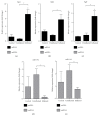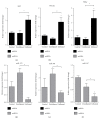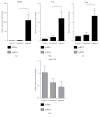Specific Gene- and MicroRNA-Expression Pattern Contributes to the Epithelial to Mesenchymal Transition in a Rat Model of Experimental Colitis
- PMID: 28572713
- PMCID: PMC5442431
- DOI: 10.1155/2017/5257378
Specific Gene- and MicroRNA-Expression Pattern Contributes to the Epithelial to Mesenchymal Transition in a Rat Model of Experimental Colitis
Abstract
The aim of this study was to determine the gene- and microRNA-expression profile contributing to epithelial to mesenchymal transition in a rat model of experimental colitis. For this, inflammation was induced by injecting 2,4,6-trinitrobenzene sulphonic acid to the colon of male Wistar rats. Samples were taken from both inflamed and uninflamed regions of the same colon, total RNA was isolated, and the mRNA and microRNA expressions were monitored. We have determined that the expression of genes responsible for inducing mesenchymal phenotype, such as Egr1, Fgf2, Fgf7, Jak2, Notch2, Hif1α, Zeb2, Mmp9, Lox, and Vim, was all significantly induced in the inflamed regions of the affected colons while the epithelial marker E-cadherin (Cdh1) was downregulated. In contrast, the expression of microRNAs miR-192, miR-143, miR-375, miR-30a, miR-107, and miR-200b responsible for the regulation of the above mentioned genes was significantly downregulated in inflamed colon. Importantly, we detected moderate induction in the expression of five out of six tested microRNAs in the uninflamed regions. In summary, we identified numerous interacting genes and microRNAs with mutually exclusive expression pattern in inflamed regions of colitis-induced rats. These findings suggest that-among others-an important step in the epithelial to mesenchymal transition in experimental colitis is the dysregulated microRNA expression.
Figures






Similar articles
-
Elevated Expression of AXL May Contribute to the Epithelial-to-Mesenchymal Transition in Inflammatory Bowel Disease Patients.Mediators Inflamm. 2018 Jul 22;2018:3241406. doi: 10.1155/2018/3241406. eCollection 2018. Mediators Inflamm. 2018. PMID: 30140167 Free PMC article.
-
MicroRNA-429 functions as a regulator of epithelial-mesenchymal transition by targeting Pcdh8 during murine embryo implantation.Hum Reprod. 2015 Mar;30(3):507-18. doi: 10.1093/humrep/dev001. Epub 2015 Jan 21. Hum Reprod. 2015. PMID: 25609238
-
miR-141 Regulates colonic leukocytic trafficking by targeting CXCL12β during murine colitis and human Crohn's disease.Gut. 2014 Aug;63(8):1247-57. doi: 10.1136/gutjnl-2012-304213. Epub 2013 Sep 2. Gut. 2014. PMID: 24000293
-
Downregulated microRNA-200a promotes EMT and tumor growth through the wnt/β-catenin pathway by targeting the E-cadherin repressors ZEB1/ZEB2 in gastric adenocarcinoma.Oncol Rep. 2013 Apr;29(4):1579-87. doi: 10.3892/or.2013.2267. Epub 2013 Jan 31. Oncol Rep. 2013. PMID: 23381389
-
Down-regulation of microRNAs of the miR-200 family and up-regulation of Snail and Slug in inflammatory bowel diseases - hallmark of epithelial-mesenchymal transition.J Cell Mol Med. 2016 Oct;20(10):1813-20. doi: 10.1111/jcmm.12869. Epub 2016 Apr 26. J Cell Mol Med. 2016. PMID: 27113480 Free PMC article.
Cited by
-
Elevated Expression of AXL May Contribute to the Epithelial-to-Mesenchymal Transition in Inflammatory Bowel Disease Patients.Mediators Inflamm. 2018 Jul 22;2018:3241406. doi: 10.1155/2018/3241406. eCollection 2018. Mediators Inflamm. 2018. PMID: 30140167 Free PMC article.
-
Early Postnatal Comprehensive Biomarkers Cannot Identify Extremely Preterm Infants at Risk of Developing Necrotizing Enterocolitis.Front Pediatr. 2021 Oct 22;9:755437. doi: 10.3389/fped.2021.755437. eCollection 2021. Front Pediatr. 2021. PMID: 34746064 Free PMC article.
-
Global alteration of colonic microRNAome landscape associated with inflammatory bowel disease.Front Immunol. 2022 Sep 13;13:991346. doi: 10.3389/fimmu.2022.991346. eCollection 2022. Front Immunol. 2022. PMID: 36177008 Free PMC article.
-
GR silencing impedes the progression of castration-resistant prostate cancer through the JAG1/NOTCH2 pathway via up-regulation of microRNA-143-3p.Cancer Biomark. 2020;28(4):483-497. doi: 10.3233/CBM-191271. Cancer Biomark. 2020. PMID: 32568179 Free PMC article.
-
Upregulation of miR-107 expression following hyperbaric oxygen treatment suppresses HMGB1/RAGE signaling in degenerated human nucleus pulposus cells.Arthritis Res Ther. 2019 Jan 31;21(1):42. doi: 10.1186/s13075-019-1830-1. Arthritis Res Ther. 2019. PMID: 30704538 Free PMC article.
References
-
- Yang G. Y., Taboada S., Liao J. Inflammatory bowel disease: a model of chronic inflammation-induced cancer. Methods in Molecular Biology. 2009;511:193–233. - PubMed
MeSH terms
Substances
LinkOut - more resources
Full Text Sources
Other Literature Sources
Research Materials
Miscellaneous

